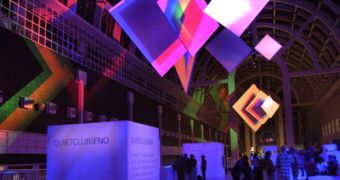The conventional incandescent light bulbs use electrical current that passes through a thin filament, heating it and causing it to become excited, releasing thermally equilibrated photons in the process. The problem is that only 2 percent of the released energy takes the form of light and the remaining 98 percent is dissipated as heat.
Now, a team of scientists at the University of Illinois created an alternative to the classical lamps that surpasses the century-old incandescent technology. They created panels of microcavity plasma lamps, very thin and lightweight, which could be used in practical residential and commercial lighting applications, but also in some biomedical applications.
"Built of aluminum foil, sapphire and small amounts of gas, the panels are less than 1 millimeter thick, and can hang on a wall like picture frames," said Gary Eden, a professor of electrical and computer engineering at the U. of I., and corresponding author of a paper describing the microcavity plasma lamps in the June issue of the Journal of Physics D: Applied Physics.
The new lamps do have something in common with the traditional fluorescent lights, being based on glow-discharges in which atoms of a gas are excited by electrons and radiate light. But the main difference is the fact that plasma is produced in microscopic pockets and requires no ballast, reflector or heavy metal housing.
One of the advantages of the new products is the fact that the plasma panels are six times thinner than panels composed of light-emitting diodes, plus they are brighter, lighter and, overall, more efficient that incandescent lights. So efficient, in fact, that they will be able to surpass even the efficiency of fluorescent lights, with some minor improvements.
Each plasma panel is made of a sandwich-like configuration of two sheets of aluminum foil separated by a thin dielectric layer of clear aluminum oxide (sapphire), with a small cavity at the heart of the lamp that penetrates the upper sheet of aluminum foil and the sapphire.
"Each lamp is approximately the diameter of a human hair," said visiting research scientist Sung-Jin Park, lead author of the paper. "We can pack an array of more than 250,000 lamps into a single panel."
The new lighting applications offer new opportunities, like lightweight arrays that can be mounted onto curved surfaces like on the insides of windshields, or could be used as photo-therapeutic bandages to treat certain diseases - such as psoriasis - that can be driven into remission by narrow-spectrum ultraviolet light.

 14 DAY TRIAL //
14 DAY TRIAL //